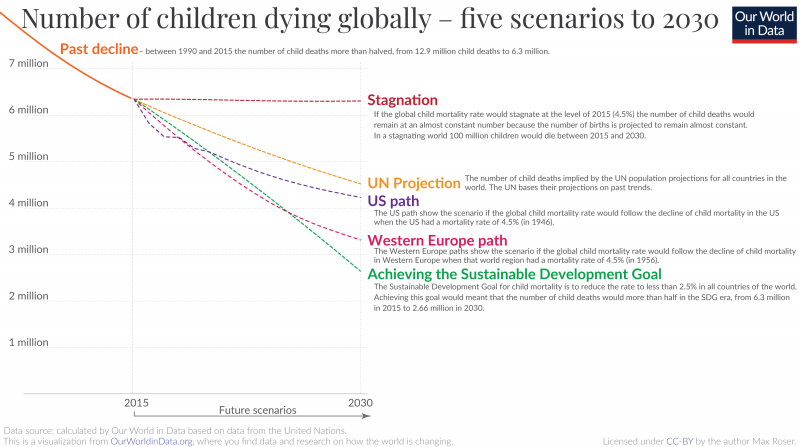Every country in the world agreed to reach the UN’s Sustainable Development Goals (SDGs).1
Goal 3.2 is to reduce the child mortality rate to at least as low as 2.5% in all countries by 2030. This would mean that more than 97.5% of all newborns would survive the first five years of their life no matter where they are born.
We are currently far away from the goal for 2030. Globally 3.9% of all children die before reaching the age of five, which means that on average 15,000 children die every day.2
And the visualization shows that while the child mortality rate declined around the world there are still many countries in which the mortality rate is higher than 2.5%.
The visualization shows five scenarios for the 15-year period of the SDG era to answer this question.
Stagnation in child health would mean 100 million child deaths in the SDG era. The number of births in the world is expected to stagnate between 2015 and 2030 at around 140 million births per year. If we assume the global child mortality rate to remain at the level it was at the beginning of the SDG era (4.5%) then we would live in a world with 6.3 million child deaths every year – 100 million child deaths until 2030.3
Stagnation, however, is not what global health researchers expect. Based on past trends and levels in 2015 the UN Population Division made projections for the number of births and the mortality rate of children in all countries of the world. According to these projections the number of child deaths will be almost two million lower in 2030 than in a stagnating world: 4.5 million child deaths. This improvement of child health would still mean terrible suffering: 86 million child deaths in the SDG era.
And while these UN projections expect a further improvement of global child health this trajectory would fall short of reaching the SDG. The scenario in green shows what it would mean to reach the SDGs. In this scenario I made a projection in which all countries would reduce child mortality to at least 2.5% and meet goal 3.2.4 Reaching the SDG would mean again almost 2 million fewer child deaths when compared with the UN projections.
Some suggest that the UN goals are set in a way that makes them easy to achieve. The motivation is supposedly that the UN defined goals which are easy to reach so that the international organization looks good after achieving them. This is not true. Just how ambitious the child mortality goal is becomes clear when you see it in historical context: The scenario called ‘US path’ shows what would happen to the global child mortality rate if it would follow the decline of child mortality in the US when the US had a mortality rate of 4.5% (in 1946). And the ‘Western Europe path’ plays out what would happen if the world would follow the path Western Europe took when it was at that level.
The SDG goal is much more ambitious than what the richest regions in the world have achieved when they had the same level of child health.
We know that it is possible to change the world. Two hundred years ago the child mortality rate was extremely high around the world – more than 40% of all children died. Since then the child mortality rate has declined more than 10-fold. In ‘The world is much better; The world is awful; The world can be much better‘ I’ve written about how we can think about the big gap between the current state of the world and what we know is possible and the big gap between the terrible living conditions in the past and the improvements since then. Because we need to further reduce child deaths we are studying the causes of death of children today and how it was possible to improve child health so very substantially in the past in our entry on child mortality.
We are currently far away from reaching the global goal for child mortality. Achieving it, however, is tremendously important – it would spare millions of families one of the most horrible tragedies anyone can imagine.

If you want to know how we are doing on the other Sustainable Development Goals: We recently built SDG-Tracker.org to allow everyone to see whether we are reaching the goals or not.